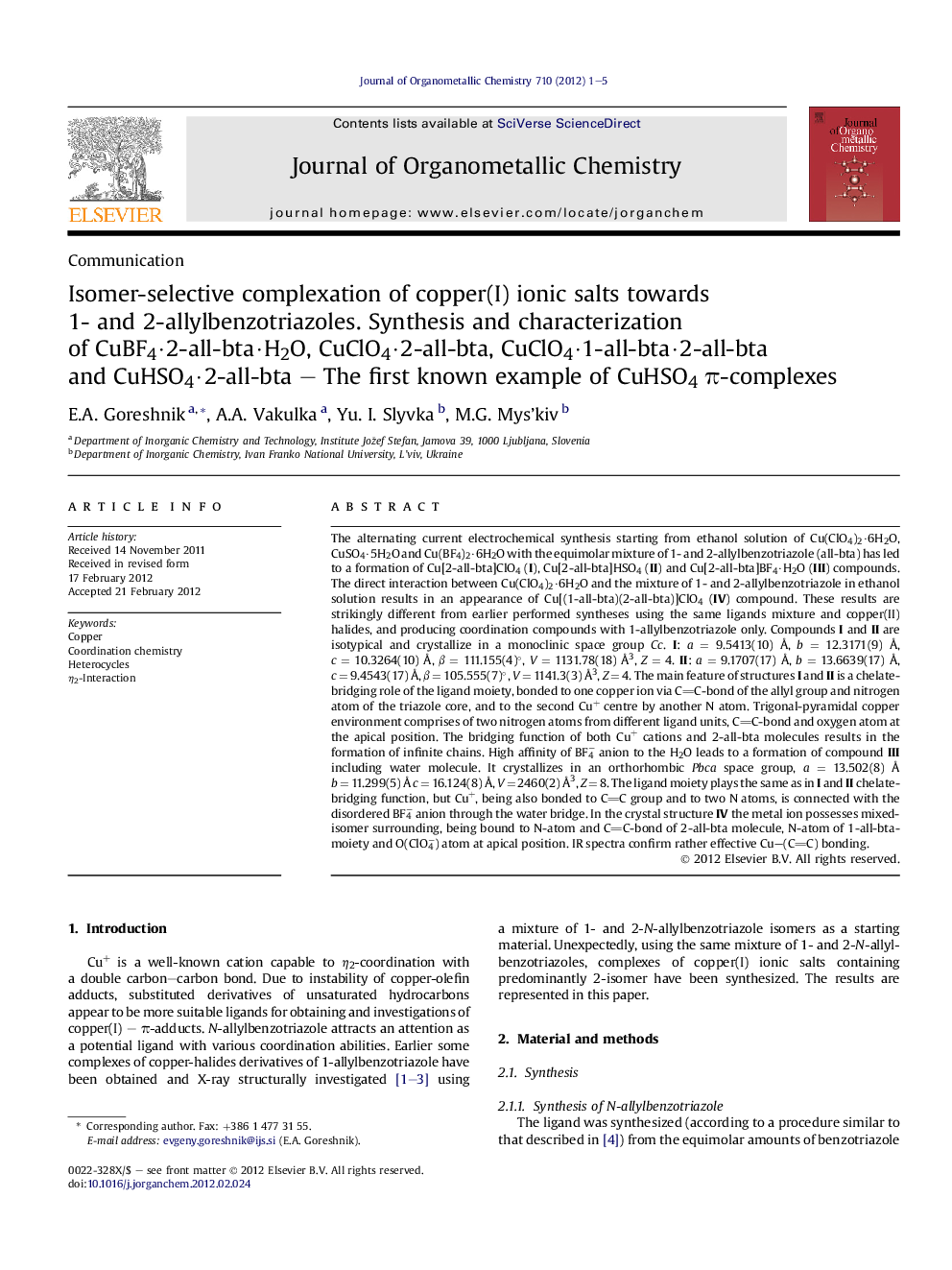| کد مقاله | کد نشریه | سال انتشار | مقاله انگلیسی | نسخه تمام متن |
|---|---|---|---|---|
| 1326171 | 1499927 | 2012 | 5 صفحه PDF | دانلود رایگان |

The alternating current electrochemical synthesis starting from ethanol solution of Cu(ClO4)2·6H2O, CuSO4·5H2O and Cu(BF4)2·6H2O with the equimolar mixture of 1- and 2-allylbenzotriazole (all-bta) has led to a formation of Cu[2-all-bta]ClO4 (I), Cu[2-all-bta]HSO4 (II) and Cu[2-all-bta]BF4·H2O (III) compounds. The direct interaction between Cu(ClO4)2·6H2O and the mixture of 1- and 2-allylbenzotriazole in ethanol solution results in an appearance of Cu[(1-all-bta)(2-all-bta)]ClO4 (IV) compound. These results are strikingly different from earlier performed syntheses using the same ligands mixture and copper(II) halides, and producing coordination compounds with 1-allylbenzotriazole only. Compounds I and II are isotypical and crystallize in a monoclinic space group Cc. I: a = 9.5413(10) Å, b = 12.3171(9) Å, c = 10.3264(10) Å, β = 111.155(4)°, V = 1131.78(18) Å3, Z = 4. II: a = 9.1707(17) Å, b = 13.6639(17) Å, c = 9.4543(17) Å, β = 105.555(7)°, V = 1141.3(3) Å3, Z = 4. The main feature of structures I and II is a chelate-bridging role of the ligand moiety, bonded to one copper ion via CC-bond of the allyl group and nitrogen atom of the triazole core, and to the second Cu+ centre by another N atom. Trigonal-pyramidal copper environment comprises of two nitrogen atoms from different ligand units, CC-bond and oxygen atom at the apical position. The bridging function of both Cu+ cations and 2-all-bta molecules results in the formation of infinite chains. High affinity of BF4− anion to the H2O leads to a formation of compound III including water molecule. It crystallizes in an orthorhombic Pbca space group, a = 13.502(8) Å b = 11.299(5) Å c = 16.124(8) Å, V = 2460(2) Å3, Z = 8. The ligand moiety plays the same as in I and II chelate-bridging function, but Cu+, being also bonded to CC group and to two N atoms, is connected with the disordered BF4− anion through the water bridge. In the crystal structure IV the metal ion possesses mixed-isomer surrounding, being bound to N-atom and CC-bond of 2-all-bta molecule, N-atom of 1-all-bta-moiety and O(ClO4−) atom at apical position. IR spectra confirm rather effective Cu–(CC) bonding.
Graphical AbstractThe Cu[2-all-bta]ClO4 (I), Cu[2-all-bta]HSO4 (II), Cu[2-all-bta]BF4·H2O (III) and Cu[(1-all-bta)(2-all-bta)]ClO4 (IV) compounds (1-all-bta and 2-all-bta are 1- and 2-allylbenzotriazoles respectively) have been obtained and characterized by single crystal X-ray diffraction and IR spectroscopy.Figure optionsDownload as PowerPoint slideHighlights
► A mixture of 1- and 2-allylbenzotriazoles has been used as a ligand.
► CuI ionic salts selectively form complexes with 2-allylbenzotriazole.
► 2-Allylbenzotriazole demonstrates chelate-bridging coordination mode.
► Changing synthetic conditions results in a mixed-isomer complex.
► The first known CuHSO4 π-complex has been obtained and characterized.
Journal: Journal of Organometallic Chemistry - Volume 710, 1 July 2012, Pages 1–5